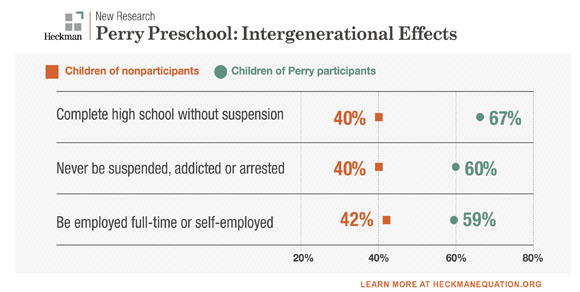
A longitudinal study of the impacts of preschool participation found that the study participants as well as their children experienced a variety of positive outcomes. The original participants had lower rates of crime, higher rates of employment, better health, and better executive function than the control group over the course of their lives. Children of the original preschool participants had a better chance of completing high school without suspension, never being arrested, and being employed full time compared to the children of the control group. The control group did not attend preschool and had similar social and economic backgrounds.
The study began in the 1960s, and the participants attended preschool for 2.5 hours a day during the school year for two years when they were 3 and 4 years old. The program also included weekly home visits. The curriculum used in the preschool was focused on active learning and intensive child-teacher interactions. Children also planned, carried out, and reviewed their own activities.
Although the sample size is small (123), the study’s author, economist James Heckman, used rigorous statistical analysis to account for this limitation. The original preschool participants, now in their 50’s, lived in Ypsilanti, Michigan and were selected to participate based on being African-American, having a low-IQ, and being disadvantaged based on parental employment level, parental education, and housing density (persons per room). Participants were randomly assigned to be part of a preschool program or have no treatment.
Libraries can apply these findings to their practices by continuing to incorporate elements of high quality preschool school, like these ideas from the National Association for the Education of Young Children (NAEYC): balancing group activities and instruction guided by the teacher with activities children choose themselves, paying attention to and supporting children’s interests, skills, and knowledge, and encouraging children’s efforts by making specific comments.
Libraries can also continue to support parents and caregivers by providing guidance on how to incorporate these strategies at home. Additionally, libraries could offer a preschool-like experience led by library staff where the caregiver stays and participates with their child.
The full report from James Heckman and his colleagues can be found here. For more information about high quality preschool, please visit NAEYC. To find quality ratings for Colorado preschool programs, Colorado Shines rates all licensed programs in Colorado.
Note: This post is part of our series, “The LRS Number.” In this series, we highlight statistics that help tell the story of the 21st-century library.